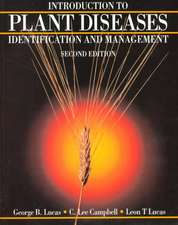Introduction to Plant Diseases: Identification and Management
Autor George B. Lucas, Lee Campbellen Limba Engleză Paperback – 30 apr 1992
Preț: 398.35 lei
Nou
Puncte Express: 598
Preț estimativ în valută:
76.22€ • 83.06$ • 64.23£
76.22€ • 83.06$ • 64.23£
Carte tipărită la comandă
Livrare economică 23 aprilie-07 mai
Preluare comenzi: 021 569.72.76
Specificații
ISBN-13: 9780412069611
ISBN-10: 041206961X
Pagini: 100
Ilustrații: 100 p.
Dimensiuni: 191 x 235 x 20 mm
Greutate: 0.66 kg
Ediția:Softcover reprint of the original 2nd ed. 1992
Editura: Springer Us
Colecția Springer
Locul publicării:New York, NY, United States
ISBN-10: 041206961X
Pagini: 100
Ilustrații: 100 p.
Dimensiuni: 191 x 235 x 20 mm
Greutate: 0.66 kg
Ediția:Softcover reprint of the original 2nd ed. 1992
Editura: Springer Us
Colecția Springer
Locul publicării:New York, NY, United States
Public țintă
ResearchCuprins
1 Agriculture, Plant Diseases, and Human Affairs.- The Study of Plant Diseases.- Plant Disease Losses.- Effects of Modern Agriculture on Plant Diseases.- What Is a Plant Disease?.- Recognizing Plant Diseases.- Management of Plant Pests.- 2 Causes of Plant Diseases.- Infectious Plant Diseases.- Disease Complexes.- Noninfectious Plant Diseases.- Names of Pathogens and Diseases.- 3 History of Plant Pathology.- In Ancient Times.- From 1600 to 1800.- The Golden Age of Biology, 1840 to 1900.- The Twentieth Century.- 4 Development of Plant Diseases.- The Occurrence of Plant Disease.- The Disease Cycle.- Environmental Effects on Disease Development.- Epidemiology of Plant Diseases.- 5 Integrated Pest Management.- Evolution of Pest Management Practices.- Low Input Sustainable Agriculture (LISA).- The IPM Concept.- Economic Thresholds.- Sources of Information.- 6 Management of Plant Diseases.- Avoidance of the Pathogen by Exclusion and Evasion.- Eradication of Pathogens.- Reduction of Inoculum.-Adjustment of the Environment.- Biological Control.- Disease-Resistant Cultivars.- Certified Seed and Seed Storage.- Summary.- 7 Chemical Management of Plant Diseases.- How Pesticides Work.- Names of Pest Management Chemicals.- Pesticide Safety.- Pesticide Formulations.- Soil Treatment.- Seed Treatment.- Postharvest Treatment.- Treatment of Growing Plants.- Pesticide Sprayers and Dusters.- Spray Equipment Parts.- Pesticide Application Guidelines.- Cleaning and Storing Equipment.- Calibration of Equipment.- Forecasting Plant Diseases as an Aid to Pesticide Scheduling.- Protecting the Environment.- Summary.- 8 Biotechnology.- Vegetative Propagation.- Regeneration of Plants from Cells.- Transplanting DNA from One Cell to Another.- Citizen Concerns and the Need for Biotechnology.- 9 Nematodes.- General Nature and Importance.- Size, Distribution, and Anatomy.- Feeding Behavior and Plant Injury.- Life History, Reproduction, and Dispersal.- Enemies of Nematodes.- Environmental Effects on Nematode Survival.- Nematodes and Other Diseases.- Management.- 10 Diseases Caused by Nematodes.- Root-Knot Nematodes.- Cyst Nematodes.- Lesion Nematodes.- Stem and Bulb Nematodes.- Stubby-Root Nematodes.- 11 Fungi.- General Nature and Importance.- Growth, Reproduction, and Classification.- Distribution and Dispersal.- 12 Diseases Caused by Soilborne Fungi.- Phytophthora Root Rots.- Damping-off.- Rhizoctonia Rots.- Fusarium Root Rots, Yellows, and Wilts.- Verticillium Wilts.- Southern Blight.- Crown and Stem Rots and Watery Soft Rots.- Cylindrocladium Black Rot.- 13 Diseases Caused by Airborne Fungi.- Rusts.- Smuts.- Downy Mildews.- Powdery Mildews.- Ergot.- Blast of Rice.- Gray Mold or Botrytis Blight.- Cercospora Leaf Spots.- Helminthosporium Leaf Spots.- Alternaria Leaf Spots.- Anthracnose.- Apple Scab.- Rhizopus Soft Rot.- 14 Fungal Diseases of Shade and Forest Trees and Decay in Wood.- Chestnut Blight.- Dutch Elm Disease.- Oak Wilt.- Annosus Root and Butt Rot.- Fusiform Rust.- Dogweed Anthracnose.- Little Leaf of Pine.- Wood Decay in Buildings.- 15 Bacteria.- Size and Structure.- Identifying Bacteria.- Growth and Reproduction.- Distribution and Dispersal.- Managing Plant-Pathogenic Bacteria.- 16 Diseases Caused by Bacteria and Mycoplasmas.- Bacterial Wilt.- Fire Blight of Apple and Pear.- Soft Rots.- Bacterial Wilt of Cucumbers.- Bacterial Canker of Tomato.- Bacterial Spot of Peach and Plum.- Crown Gall.- Mycoplasma Diseases.- 17 Viruses.- Discovering Plant Viruses.- Naming of Viruses.- Symptoms of Virus Diseases.- Properties and Morphology.- Identification and Detection.- Transmission.- Management.- 18 Diseases Caused by Viruses.- Tobacco Mosaic.- Vein Banding or Streak.- Tobacco Vein Mottle.- Tobacco Etch.- Tomato Spotted Wilt.- Cucumber Mosaic.- Barley Yellow Dwarf.- Soilborne Wheat Mosaic.- Maize Dwarf Mosaic and Maize Chlorotic Dwarf.- Viroid Diseases.- 19 Diseases Caused by Parasitic Plants.- Broomrapes.- Witchweed.- Mistletoes.- Dodder.- 20 Abiotic Agents.-Deficiencies and Toxicities.- Weather Extremes.- Abnormal Water Conditions.- Phytotoxic Chemicals.- Air Pollution.- Suggested Readings.




